First
Steps of The EMBLA Project in Hessdalen
A
Preliminary Report
Massimo
Teodorani, Ph.D.
Astrophysicist,
Scientific Supervisor of ICPH http://www.itacomm.net/PH/
Scientific
Consultant of CNR-IRA
Via Catalani 45 - 47023 Cesena (FC) - ITALY
email:mteo@linenet.it
Stelio
Montebugnoli, MScEE
CNR
Leading Technologist and Director
Director
of EMBLA 2000 Project
Stazione
Radioastronomica CNR-IRA
Via Fiorentina - Medicina (BO) - ITALY
email:stelio@ira.bo.cnr.it
Jader
Monari, MScEE
CNR
Technologist - Contractor
Stazione Radioastronomica CNR-IRA
Via Fiorentina - Medicina (BO) - ITALY
email:jmonari@ira.bo.cnr.it
ABSTRACT. In August 2000 a team of italian physical scientists, working in collaboration with norwegian scientists from Østfold College, carried out an instrumental expedition in Hessdalen, which was just the first of a series of future scientific missions planned by the joint italian-norwegian EMBLA Project. The employed radio spectrum analyzers, which were automatically in function all the time for 25 days, permitted to discover highly anomalous periodic signals which were caracterized by a spike-like and a doppler-like morphology. Moreover, during the many planned skywatching sessions, it was possible to sight repeatedly luminous atmospheric phenomena in varius points of the Hessdalen valley. This paper represent a preliminary report on this mission, in which both radio and visual phenomena are described. A speculative model explaining some aspects of the recorded anomalous radio signals is also discussed.
1. Introduction
The EMBLA Project was born in 1998 as a joint research initiative between the CNR (Consiglio Nazionale delle Ricerche) Istituto di Radioastronomia (IRA) based in Medicina (BO) and the Østfold College of Engineering based in Sarpsborg (Norway). The goal of EMBLA is of studying the electromagnetic behaviour of unexplained luminous phenomena occurring recurrently in Hessdalen (Norway), by using sophisticated radio receivers and spectrometers. After several meetings with Erling Strand and Bjørn Gitle Hauge, assistant professors of Østfold College and principal investigators of "Project Hessdalen", it was finally decided to install the CNR-IRA instrumentation in Hessdalen during the month of August 2000. Such instruments have been continuously operating for 25 days. The Hessdalen phenomenology is officially well known since 1984 (refs. 10, 23, 24, 25, 29, 31, 32, 35, 37). Together with several other cases of recurrent luminous phenomena in the world (refs. 12, 13, 15, 19, 20, 26, 27), Hessdalen is the living proof that atmospheric light phenomena can be particularly concentrated in specific areas of the world. The reason why all this occurs is still unknown, even if several theories have been proposed (refs. 6, 21, 25, 34, 41). The phenomenon in Hessdalen was investigated for the first time with magnetometric, radiometric and radar instrumentation in 1984 by Erling Strand and his staff (ref. 23): such a pilot instrumental investigation was non-stop and lasted about 40 days during a period in which the Hessdalen phenomenon was crossing a "flap" phase. This first effort demonstrated that the light phenomenon is measurable indeed, beeing able to reflect radar waves, to produce local magnetic perturbances and to cause unexplained "spike-like" radio-signals in the HF-VHF range. The subsequent EMBLA project, which was put in practice for the first time in the year 2000, was just aimed at examining closely the radio characteristics of the Hessdalen phenomenon. Regarding the specific radio field, the main advantages of the EMBLA Project in comparison with former measurements carried out by Project Hessdalen in 1984 are the following ones: a) a much wider frequency range (in this case, expanded with the ELF, VLF and UHF radio windows) and resolution, b) a much higher sensitivity, c) a totally automated mode of data acquisition. As the Hessdalen phenomenon (HP) generates light which, according to the previously obtained data, is able to affect the earth’s magnetic field, the current aim of the EMBLA project is to map out radio emission from HP and thereby determine the spectral energy distribution, the emission mechanism and, in case, the chemical composition of plasmoids due to HP. Since august 1998 Project Hessdalen is operating with optical automated instrumentation consisting of a very sophisticated video-camera. Compared with the 1984 observational period, the monthly incidence of luminous phenomena in Hessdalen nowadays (1998-2000) has sensibly decreased. On the other hand, the possibility of a constant monitor by means of an automated video-camera, has highly increased the capability of recording the apparition of such phenomena all the time. A Panasonic solid-state videocamera supplied with a wide-angle lens, which is connected with a videorecorder and a Silicon Graphics Indy computer, is currently installed in the Hessdalen Interactive Observatory (see Figure 1, refs. 1, 2, 28). Such a system is able to perform every second a complete survey of an accurately chosen area of the Hessdalen valley and to record any target whose luminosity is greater than a threshold value; the recorded frames are immediately made available to researchers through the web site of Project Hessdalen (ref. 29). Each of the recorded optical phenomena is re-analyzed in a subsequent phase, in which case a selection of real "anomalous cases" is done by carefully distinguishing such cases from identified objects (such as airplanes or celestial objects). Uncertain cases for which only a preliminary analysis has been done, are considered as well: a consistent number of such cases are possibly destined to be regarded as real anomalous cases after a further analysis. The selected data furnished by the video-camera which have been obtained so far are shown in Fig. 2. The data coming from the automatic video-camera may be well indicative of the realistic trend according to hour and month followed by the Hessdalen lights, but not of the real number of the appearing lights. The Hessdalen Interactive Observatory (HIO) is placed in the most probable position to see lights, but: a) the angle of sight is limited to a bit more than 100°, b) the employed sensor is not able to record very faint or very short-lasting lights, c) light phenomena which are very far from the HIO observatory or hidden by hills or occurring on the opposite side of HIO cannot be recorded. Therefore, the statistics which is deduced with the present observatory can be considered reliable in order to show a "relative distribution" according to time, but the obtained numbers should be multiplied by a scale factor which so far cannot be easily evaluated. The HIO observatory is also supplied with a Fluxgate magnetometer which is able to furnish hour by hour the intensity of the local magnetic field (ref. 30). At the present time, Project Hessdalen is going to expand soon the available instrumentation with: a) new optical CCD sensors, b) an advanced radar, c) a new magnetometer, d) a second observing station installed in a different point of the valley in order to furnish a three-dimensional and stereographic representation of the phenomenon. In such a way the huge efforts which have been done so far by means of the presently working norwegian Hessdalen Interactive Observatory, are strictly connected with the present efforts of the italian-norwegian EMBLA initiative in the radio field, which was born just thanks to the pioneering monitoring work carried out by Project Hessdalen in 1984. As a first test of this scientifical and technological joint international collaboration, in August 2000, in addition to the presently working automated videocamera, the current Hessdalen Interactive Observatory has been equipped for about a month with a platform of automated radio instruments which were projected by the technologists of the Istituto di Radioastronomia (CNR). Such radio instruments (see Fig. 1), just representing the "EMBLA 2000" starting project, were the following ones:
A. ELFO unit. A VLF-ELF & Correlation Receiver and Spectrometer connected to loop antennas, and then sensitive to a magnetic field in the 1KHz - 14KHz range.
B. INSPIRE unit. A VLF Receiver and Spectrometer connected to a dipole antenna, and then sensitive to an electric field in the 1KHz - 100KHz range (refs. 7, 8, 39).
C. SS-5 and SENTINEL-1 units. Two spectrometers connected to a 1420 MHz receiver with 5 and 10 MHz bandwidth at 10Hz and 10KHz resolution respectively (ref 17).
D. A wide-band antenna connected to an HP spectrum analyzer scanning from 0.1 GHz - 1.8 GHz.
All such instruments were computer-controlled and data, which were recorded automatically and continuously, were stored on CD ROMs. This big amount of data (about 21 GBy, compressed) will be analyzed in detail as soon as the post-processing phase will be in progress.
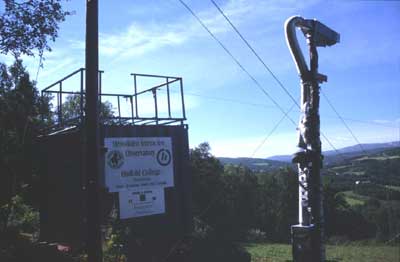
Figure 1a. The Hessdalen Interactive Observatory (HIO)
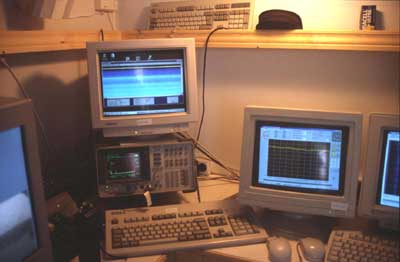
Figure
1b. The EMBLA monitors inside the HIO.
The italian-norwegian group, which was mainly composed by electronic engineers Stelio Montebugnoli (director of the EMBLA 2000 Project) and Jader Monari, astrophysicist Massimo Teodorani, electronic engineers Bjørn Gitle Hauge and Erling Strand, carried out also a very intense skywatching activity during night-time. Luminous and peculiar phenomena were repeatedly observed, and sometimes photographed, in different zones of the Hessdalen area. An exhaustive photographic report of the EMBLA 2000 mission has been published on the web (ref. 16).
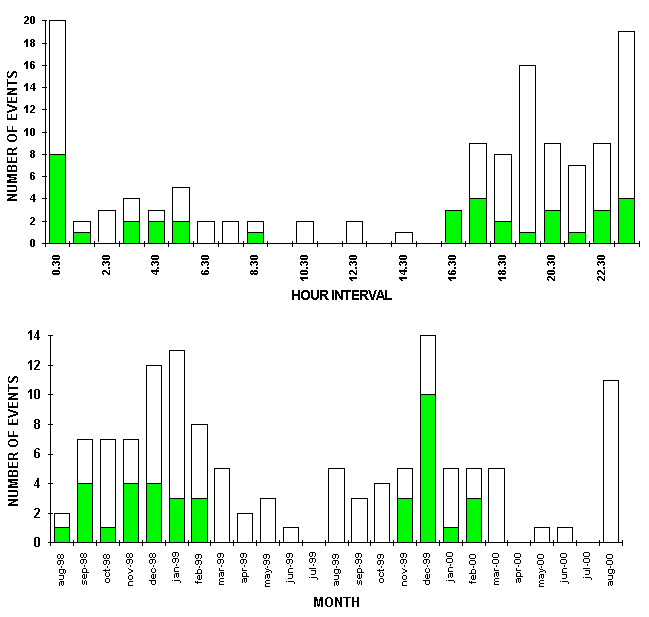
Figure 2. above. Hourly
number of luminous events reported in the period August 1998 - August
2000 (lower dark bar: ascertained anomalous cases, upper clear bar:
still uncertain cases).
Figure 2. below. Monthly number of luminous events reported
in the period August 1998 - August 2000 (lower dark bar: ascertained
anomalous cases, upper clear bar: still uncertain cases).
2. Radio spectrometric measurements
During almost all the month of August 2000 very anomalous signals were often recorded. With the VLF "Inspire" receiver in particular, it was also possible to record "screen snapshots" at any time in which, during the monitor by the personnel, it was possible to detect such signals. The anomalous signals which immediately attracted the personnel’s attention were the following two ones:
I. SPIKE signals. Spike-like signals appeared in the range 3-7 KHz (see Fig. 3) just as very sharp and straight "narrow lines". Spikes behaved in a strictly periodic way by showing regularly "On" and "Off" phases
II. DOPPLER signals. Doppler-like signals, which sometimes accompanied the spike-like ones, appeared intermittently in the range 1-2 KHz as more or less inclined "broad lines", and covered a narrower frequency interval (see Fig. 4) than the spike-like signals. From the measured frequency shift it was possible to determine a velocity of the emitting source which was changing in a very short time (of the order of some seconds) from 10.000 up to 100.000 km/sec. The inclination of "broad lines" was occasionally changing from "negative" to "positive": this clearly indicated that the doppler shift was both red-wards and blue-wards.
Such anomalous signals, which occurred both at day-time and at night-time were also accompanied and/or overlapped with several other types of signals, mostly irregular and asymmetrical, many of which are suspected to be due to "natural noise" of solar or atmospheric origin. No luminous phenomena could be reported while the personnel was controlling the monitors of the radio spectrometers. Any kind of possible time synchronicity of anomalous radio signals and anomalous light phenomena which were reported during the skywatching activity, will be ascertained after all the radio data will be processed, as a precise timetable of the luminous events which were sighted is available. During the EMBLA operations, it was possible to exclude any possible interference due to other electronic instruments or electric connections which were just near the used spectrometers. For instance, although everything else was turned off as a test, the INSPIRE receiver continued to register exactly the same signals. A much more detailed behaviour of both kinds of signals has been recorded by the ELFO receiver, by means of which it is possible to perform Fourier transforms. Analogously, the SS-5 and SENTINEL-1 spectrometers showed anomalous signals too. As the signals recorded with these 3 spectrometers didn’t allow an immediate and on-line check also because of the practical impossibility of extracting snap-shots in these cases, a definitive diagnosis will be possible only when the post-processing phase will be over. Anyone of the 4 employed spectrometers acquired continuously data during one month, for a total amount of 21 GBy (compressed) stored in CD ROMs. The main post-processing procedures which are currently carried out by the EMBLA team, are described in a final technical note at the end of this chapter. Such planned measurements (including "WAV" signals) must allow to build up a quantitative picture of the recorded radio phenomena, regarding the whole period (about one month) in which spectrometers were in function.
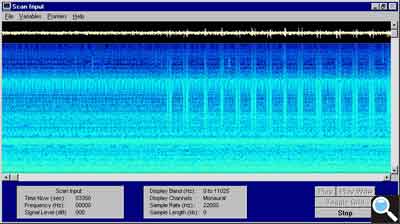
Figure
3. Spike signals recorded with the INSPIRE receiver (Y axis: frequency,
X axis: time).
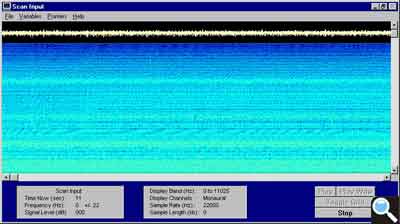
Figure
4a. Doppler signals recorded with the INSPIRE receiver (Y axis:
frequency, X axis: time). Blue-shifted signals.
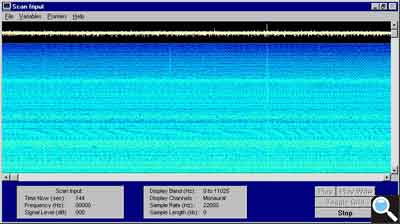
Figure
4b. Doppler signals recorded with the INSPIRE receiver (Y axis:
frequency, X axis: time). Red-shifted signals.
TECHNICAL NOTE: The following post-processing procedures are currently executed:
a. Internal Noise Extraction. In order to eliminate any possible source of instrumental noise in the data.
b. External Noise Evaluation and Extraction. In order to evaluate or eliminate any source of noise due to well-known natural sources such as solar activity, atmospheric and ionospheric activity, earth or rocks activity and human artificial causes (refs. 34, 35, 37, 39, 41).
c. Micro Periodicity. In order to measure the exact time intervals during which spike events occurred.
d. Periodicity of Doppler Reversal. In order to establish the length of the cycle between redshifts and blueshifts in the doppler signals.
e. Period Variability. In order to verify if, when and how the duration of spike-to-spike intervals vary with time.
f. Macro Periodicity. In order to evaluate how long is the duration of any period of time in which spike and doppler events are continuously present, and to verify if such periods occur with a precise order or logic or if they occur erratically.
g. Signal Intensity. In order to measure the exact amplitude of any interesting signal (spike or doppler) and verify with which mode the signal is appearing (smoothly or sharply) and/or disappearing.
h. Signal Morphology. In order to verify if, when and how there are different types of spike or doppler signals.
i. Frequency Bandwidth or Shifts. In order to verify if, when and how the frequency window in which spikes or dopplers are present gets narrower or broader, or if some bandwidth shift occurs in such events.
j. Radio-Optical Synchronicity. In order to deduce what was the radio behaviour around the time in which light phenomena were sighted.
3. Optical Sightings and Typology
The operating team was also devoted to the visual observation of luminous phenomena. Such kind of skywatching was carried out mostly at the Aspåskjölen site (also called "Vista Point"), but also near the Finnsåhögda mountain and in Bredslettet not far from the Öyungen lake. Different types of visual observations were done and only in two cases it was possible to take photographs of the phenomenon. The personnel was equipped with the following portable facilities: a videocamera, a reflex camera mounted on tripod, an image intensifier / IR viewer, binoculars, a fast optical detector, a mini X-ray detector and a Geiger counter; moreover powerful torches (crypton and xenon types), mini-lasers and compass, were used in order to signal the positions of different groups of skywatchers. Not all the facilities could be used in order to monitor the light phenomena: the videocamera, the reflex camera, the binoculars and the image intensifier, were the mostly employed facilities. During the observations which were carried out, it was possible to ascertain that the so called "Hessdalen phenomenon" is really multiform. The phenomenon showed to be characterized both by pulsating lights and by approximately constant or slowly variable lights, both by plasma-like lights without a defined countour and by lights with a very defined contour or by lights which were co-moving following a precise geometric shape, both by short-lasting and by long-lasting lights, both by lights on the ground and by lights in the sky. Moreover, videos of pulsating lights at their maximum showed a saturated core (see Fig. 5), which was indicating that during the maximum the luminous intensity reached extremely high values. The observed phenomena (see Figs. 5, 6) are schematically described as follows.TYPE 1:
Strong irregularly pulsating white lights.
Distance:
20-25 Km, Direction: south, Position: between two mountains,
Color: white, Duration: 10-30 seconds for each pulsating
event, Regime of motion: approximately standing still, Number
of Events: several events during 3 nights, Luminosity: very
high with drastic change of radiating surface and with an occasionally
saturated nucleus, Shape: approximately spherical, Height above
ground: probably few meters, Dimensions: from 1 to 10 meters,
Time: 23.00 - 01.00, Witnesses: 4-6, Sighting Location:
Aspåskjölen, Report type: visual, video (see Fig. 5),
intensified/IR, binocular and photographic (photos underexposed).
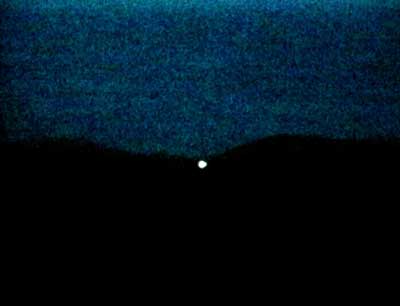
Figure
5a. Pulsating light sighted from Aspåskjölen (TYPE 1).
The present image is the result of summation of 15 (1/25 sec) close video
frames (video acquired by J. Monari and processed by M. Teodorani).
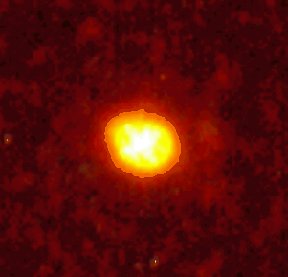
Figure
5b. Pulsating light sighted from Aspåskjölen (TYPE 1).
This frame was obtained when the light, which shows a saturated core,
was at the maximum intensity (video acquired by J. Monari and processed
by J. Monari and M. Teodorani).
TYPE 2:
Faint regularly pulsating light with color changement.
Distance:
6-7 Km, Direction: north, Position: very low in the sky
(about 10°). Color: white, red, green, blue, Luminosity:
more or less faint - changing from star-like to planet-like, Color,
Surface and Luminosity Change Rate: 1-2 seconds, Duration:
40 minutes, Number of Events: 1, Regime of motion: standing
still, Shape: approximately spherical, Height above ground:
probably 500-800 meters, Dimensions: unvaluable, Time: 00.43
- 01.25, Witnesses: 3, Sighting Location: Bredslettet (not
far from Öyungen lake), Report type: visual, binocular and
photographic (photo very faint).
TYPE 3:
Point-like flashes.
Distance:
300 meters - 3 Km, Directions: all, Position: low in the
sky just over the top of the hills, or on the ground. Color: white-blue
and orange (one case), Luminosity: normally strong, Duration:
½ seconds, Number of Events: many, Regime of motion: standing
still or erratically moving, Shape: point-like or, more seldom,
line-like, Time: at any hour of the night, Witnesses: 2-3,
Sighting Location: everywhere in the valley, Report type:
visual.
TYPE 4:
Diffuse flashes in the valley.
Distance:
1-2 Km, Direction: west, Position: low in the valley or
on the ground. Color: white, Luminosity: very strong, sudden
illumination of all the valley, Duration: ½ - 1 seconds, Number
of Events: 2, Time: 23.30 - 24.00, Witnesses: 1, Sighting
Location: hillside up to Finnsåhögda south, Report type:
visual.
TYPE 5:
Three co-moving lights in the sky: the "Triangle".
Distance:
undetermined, Direction: from south to north, Position:
moving in the sky from 20° (low over horizon) up to 80° along a maximum
circle which was close to the zenith, Speed: about 30°/min, Color:
white-yellow, Noise: none, Duration: 2-3 minutes, Regime
of motion: complex of 3 co-moving lights in an exact triangular disposition,
which first moved linearly and slowly towards the observers, then stopped
for 5-10 seconds at an height of about 80° while doing a 90° rotation
around its axis, lastly slowly disappeared (about over the observers’
vertical), Number of Events: 1, Luminosity: slowly changing
from Jupiter-like intensity to star-like intensity, Shape: point-like
lights disposed in a geometrical configuration (exact equilateral triangle)
- underlying dark triangular object visible with binoculars, Radioactivity:
normal level, Height above ground: undetermined, Angular Dimensions
of the Triangular Complex: 3-5°, Time: 24.00 - 24.15, Witnesses:
4 (2 groups), Sighting Locations: Aspåskjölen and near
Finnsåhögda, Report type: visual, binocular, intensified/IR
and Geiger.
TYPE 6:
Small stationary light in the wood.
Distance:
about 100 meters, Direction: east, Position: standing still
behind the first row of trees and just in front of the meadow in Aspåskjölen,
Color: white-yellow "neon-like", Noise: a whistle
while its light was slowly turning on, Duration: about 10 minutes,
Number of Events: 1, Luminosity: constant and at low level
(100 W bulb-like), Shape: elliptical (with very defined contours
clearly distinguished by binocular sight), point-spread-function not resembling
a plasma-like object, Height above ground: about 2 meters, Dimensions:
30-40 cm, Time: 23.00 - 23.30, Witnesses: 3, Sighting
Location: just in Aspåskjölen, Report type: visual,
binocular and photographic (see Fig. 6).
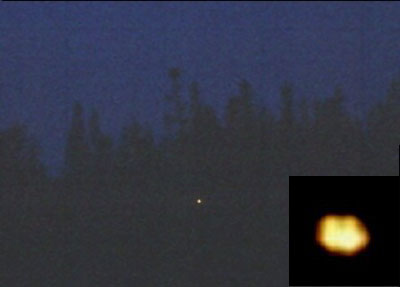
Figure
6. Small light sighted near the trees in Aspåskjölen (TYPE
6).
Photograph was obtained with a 200 ASA film and an exposure-time of 10
sec (photograph and processing by M. Teodorani).
A delegation of the Hessdalen inhabitants was met, thanks to writer Peder Skogaas’ initiative. Without telling them what the EMBLA team saw during the previous nights, their own stories regarding the period 1981-2000 were just listened and carefully evaluated. They had the occasion to report very often many of the same phenomena which the EMBLA personnel saw in August 2000. These persons hope that scientists and their equipment can furnish a definitive answer to what they repeatedly saw in Hessdalen.
4. Discussion
The EMBLA staff came back to Italy with a big amount of radio data, also having had repeatedly the opportunity of sighting anomalous light phenomena. The sighting of light phenomena has a value of a pure "witness report", as unfortunately this year it was not possible to bring sophisticated instrumentation aimed at taking optical measurements such as CCD frames and spectra: this specific procedure has been planned for a further phase of the EMBLA Project (refs. 34, 36, 38). Anyway it must be recognized that the extraordinary match between the sightings by the EMBLA team and the ones reported over and over again by the Hessdalen inhabitants plays in favour of the existence of the visual phenomenon in the bi-modal form with which it has been reported since at least 20 years: without any sort of doubt unstructured and plasma-like lights often co-exist with "structured objects" for a reason that is not possible to explain by now, except when the EMBLA Project will be in a condition to couple current radio measurements with sophisticated radar-assisted optical astronomy-like measurements (ref. 36). On the basis of the multiple witnesses and of the critical weight that was given to the stories which were expressly told by a delegation from Hessdalen, it has been possible, at least, to be able to form a more correct idea of the Hessdalen phenomenon as it appears since a long time in that norwegian valley. The sightings of type 1 up to 4 match very well the first accurate technical report by Project Hessdalen (ref. 10, 23, 24). The sightings of type 1 up to 2 are also very similar to phenomena observed elsewhere in the world (refs. 3, 9, 10, 12, 13, 15, 19, 20, 26, 27). Moreover, the sightings of type 5 up to 6 are extremely similar to previous reports in other world areas (refs. 3, 9, 11, 18, 40) and partly similar to what is reported also by Project Hessdalen itself (refs. 10, 31, 32). What is of scientific importance in this EMBLA 2000 mission, the first one of a series, is the fact that it was possible to monitor accurately for an entire month and without interruption the radio range of the electromagnetic spectrum and that, after the predictably very long post-processing phase will be completed, there will be the possibility to map precisely the electromagnetic field in the Hessdalen area. Moreover, it will be soon possible to check which radio signals have been recorded at the moments of optical sightings: this check could emphasize the value of visual reports even more. The EMBLA group is already in a condition to declare that the "spike signals" which were recorded in the VLF range resemble almost exactly similar signals which were observed by: a) the norwegian spectrometers in 1984 in the HF-VHF range (ref. 23), b) microwave astrophysicists in Antarctica in 1991 in the UHF range (ref. 22), c) the "Elfrad group" in 2000 in the ULF range (ref. 4). All this shows very clearly that spike signals may be recorded in a hugely broad frequency range. What is not known yet is if such signals are simultaneously received at all the frequency windows or if there is a temporal shift from one frequency window to another. In order to ascertain this it will be necessary to check what the other EMBLA spectrometers (ELF and UHF) have recorded all together. Next year the installation of an ULF spectrometer has been planned too. According to the highly peculiar signals which were occasionally extracted from snap-shot frames (spike and doppler signals) coming from the INSPIRE receiver, it is already possible to sketch logical-speculative physical models which could explain both the spike and the doppler signal morphology. Such models, by now, can be deduced by purely geometrical and intuitive considerations.
a. What could cause Spike Signals ?
1. An uniformly emitting possibly spherical source which is periodically turning on and off with a pulsational mode and with a rate of the order of some fraction of second for any spike event.
2. A rotating spherical, cylindrical or disk-like source with an emitting spot on its surface. In such a case the observer could detect the signal only when the emitting spot is directed towards him (during intervals of the order of some fraction of second). The width of any recorded spike signal could depend on the surface area of such an hypothesized emitting spot.
In some cases it was possible to verify that the intensity of spike signals was slowly increasing or decreasing: this observational evidence could be interpreted as the gradual approaching or receding of a pulsating or rotating invisible radio-emitting source. In some other cases it was possible to observe that the spike signals were appearing or disappearing abruptly (see Fig. 3): this evidence could be explained by very fast velocities of the moving body or by the sudden onset of pulsation or rotation of an invisible source which was standing still nearby. There are not elements yet to ascertain if such a source is of natural origin (ref. 6, 21, 33, 34, 35, 37, 39, 41) or not (ref. 3, 9, 10, 11, 32, 33, 34, 38, 40, 46) and no elements to verify if the perturbing region is located in the local atmosphere, on the ground, or underground.
b. What could cause Doppler Signals ?
The very high measured velocities (10.000 up to 100.000 km/sec) cannot be produced by a physical body in fast motion. The only realistic possibility according to the accepted physics theory is that such a velocity is due to particles which are accelerated to semi-relativistic velocities by an unidentified rotating spheroidal body and that the particle acceleration occurs along a more or less collimated magnetic axis (see Fig. 7, already cited in an interview [ref. 5]). In order that the doppler signal appears as such and with a periodical mode, it is necessary that the magnetic acceleration axis B is misaligned in comparison with the rotation axis A: in such a way a "lighthouse effect" would be acting. It is possible to obtain different doppler configurations according to: a) the angle between axes A and B, b) the angle between the rotation plane and the line of sight C, c) the opening angle of the beam of accelerated particles. Let’s assume that rotation occurs in the same plane as the line of sight. If the angle between A and B is zero no signal should be observed (velocity relative to observer = 0) unless the opening angle of the particle beam is very wide. If the angle between A and B is non-zero it could be possible for the observer to receive a periodic signal with a moderate doppler velocity (velocity relative to observer > 0). If the angle between B and C is zero, then it is possible to receive periodically an highly doppler-shifted signal (velocity relative to observer >> 0): in such a geometric configuration the maximum doppler (blue-shifted) velocity could be reached.
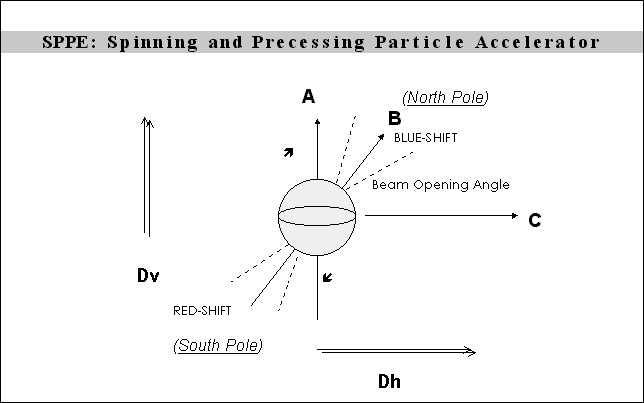
Figure
7. The SPPE model proposed to explain doppler signals.
A: Rotation Axis, B: Particle Acceleration Axis, C: Direction to Observer,
Dh: Translatory Motion of the Body, Dv: Vertical Motion of the Body.
In order to explain signals characterized by a rapid change of the doppler effect intensity (see Fig. 4) it is necessary to invoke the following three possibilities: i) the angle between A and B changes, being the angle between A and C fixed, ii) the opposite situation as i), iii) the velocity of the accelerated particles is intrinsically changing. Assuming the SPPE model, in order to explain the observed "doppler reversal" (from blueshift to redshift, or viceversa) which can be noticed in Figures 4 and 8, it is necessary to hypothesize that particle injection, which is modulated by rotation, is mono-polar: I) blueshifts are due to particles which are injected when the beam is aimed at the observer, II) redshifts are due to particles which are injected when the beam is opposite to the observer. This can happen or from the north pole or from the south pole of the magnetic axis B (see Fig. 7), but not from both of them. Anyway a mono-polar behaviour seems not to be the rule, as some other signal features coming from our INSPIRE snap-shots show that the inclined doppler shifted lines are sometimes substituted by a continuous "band" which is almost always interrupted by periodic voids (see Fig. 8). Such a broadened "band" could be the result of the "melting down effect" due to the co-existence of both blue and red-shifts which would work simultaneously. In such a case one would be induced to invoke the onset of a bi-polar mode for particle outflow, in which both approaching and receding beams would be observed together (see Fig. 7). The periodic appearance of voids would occur at the instants in which the bipolar beam is neither approaching nor receding the observer: this happens only when the bipolar magnetic axis lays on a plane which is perpendicular to the line of sight, in which case the relative velocity of the particles ejected from the north and the south poles of the magnetic accelerating tube, becomes zero. The instants in which a zero relative velocity is reached (twice in a single rotation cycle) are very short because it is assumed that the bipolar outflow is rotating more or less fast. All this means that the time-duration of the voids is linearly dependent on the velocity of the spinning body. In such a way we have two extreme cases: a) very fast rotation causing an almost continuous band, b) very slow rotation causing a band which is interrupted by large voids. All these specific configurations have been encountered in several of the obtained 38 snap-shot frames.

Figure
8. LEFT. Red-shifted signal. CENTER. Blue-shifted signal. RIGHT.
Mixture of blue and red-shifted signals, resulting in a continuous "band"
interrupted periodically by voids.
In conclusion, by taking the obtained data into account and by assuming that the SPPE intuitive model is valid, one is induced to suspect that an inclined precessing and collimated magnetic particle accelerator is ejecting semi-relativistic particles by alternating monopolar and bipolar modes, by changing both the spin velocity and the beam opening angle. In general, such an emission mechanism is very similar both to the "pulsar mechanism" (refs. 14, 43) and to the "relativistic ouflow mechanism" in astrophysics (refs. 44, 45), which in the present case are combined in a very specific framework. In the present framework it is not known if relativistic particles are accelerated continuously or intermittently: in the second case we would have a more complicated signal morphology. As in some cases spike and doppler signals were present together, one is induced to think that the "mystery source" is characterized both by a purely pulsing radio emitting behaviour (maybe due to a rotating spot) and by a particle acceleration mechanism which produces in some way radio waves too. The second aspect is really very interesting: astrophysical mechanisms of particle acceleration, which can be found in particular in the "extragalactic jets" (ref. 44) and in some high-energy stars such as SS433 (ref. 45) produce radio radiation indeed, whose emission mechanism - the well-known "synchrotron" - is due to relativistic electrons which are accelerated by highly intense and collimated magnetic fields. Maybe something in a much smaller scale is imitating what is normally happening in a much larger scale: are they unknown high-energy mechanisms of our atmosphere, or the consequence of some propulsion mechanism of unknown origin? Such qualitative interpretative models are not certainly the last word in order to explain the way in which the emission mechanism works effectively, but it is a first stimulation to think of what may be happening with some of the radio signals in Hessdalen, in order that after the post-processing phase will be over it could be possible to carry out a numerical simulation which could favour or reject the present models. Finally, it is very probable that when all the 21 GBy total amount of (uncompressed) data will be fully processed, many radio signals due to the solar activity, which just on August 2000 was at the maximum of its 11-year cycle (ref. 42), will be repeatedly found. Some irregularly oscillating signals were found indeed: they could be due to enhanced solar activity, and it will be ascertained in a further phase. Nevertheless, differently from what was deduced during a previous analysis of the Hessdalen phenomenon (refs. 25, 35, 37), at the present time strong doubts exist that the extremely regular signals which were detected this year have something to do with solar activity. Anyway the EMBLA team will try to ascertain even more if spike signals in particular are caused by an unidentified transmitter due maybe to some electric machinery working in Hessdalen, even if already now there are also doubts that such devices like electric saws, for instance, can be working uninterruptly fo a so long time and also during the night-time.
5. Conclusion
Doing science means mainly applying two concepts: "exploration" and "understanding". A third concept, "formal representation", is also important, but it is a mean, not the goal. What is happening in some places in the world seems to teach us that we certainly know much of physics but not all of it. The very fortunate circumstance of having at our disposal very sophisticated technology for the measurement of radiation at any wavelength, is the best chance for us to carry out a quantitative analysis of what is still unknown. In such a way we are in a condition to build up new models for a more complete description of our physical world. Our main goal is to know which relation exist between the Hessdalen-like lights and the detected peculiar radio signals. This task can be reached only if the luminous component of the Hessdalen phenomenon can be accurately studied by means of portable astronomy-like sensors and analyzers such as CCD imagers and spectrographs: we can obtain such kind of data simply by joining together a Celestron-like mini-telescope, a CCD camera, a diffraction grating and a Pentium notebook, all at the cost of the order of $ 10000 or less, and apply them to the study of anomalous lights. This technique, which can be applied more succesfully to the study of lights of the "stable" types 1 and 2, is really very naive but the predicted scientific results would be huge. Much more sophisticated optical instrumentation has been projected indeed (refs. 34, 36). The philosophy of this exciting research is extremely similar to the one which we use to study celestial objects, where we are able to deduce physical mechanisms at work by analyzing the entire spectrum of the electromagnetic radiation. Only a difference: the Hessdalen-like phenomena (refs. 10, 12, 13, 15, 19, 20, 23, 26, 27) are just here and the emitted radiation is so intense that we can say that we have at our disposal a very good laboratory, with which, by obtaining very high S/N ratioes, we are in a condition to do a much more accurate physics than in the case of faint celestial sources.
Acknowledgments
The authors of this article are deeply indebted with the following persons and groups:
1. Renzo Cabassi and his staff of the ICPH (Italian Committee for Project Hessdalen) for putting at the disposal of Dr. Massimo Teodorani all the necessary money funds to participate to this scientific expedition, and for the intellectual, moral and technical support before and after this mission.
2. CNR technicians A. Cremonini, F. Tittarelli, S. Mariotti, A. Maccaferri and A. Cattani, without the precious contribution of whom the installation of antennae, receivers and computers, and the scientific mission itself would have never been possible.
3. Assistant Professors Erling P. Strand and Bjørn Gitle Hauge of the Østfold College of Engineering, and Thor Stuedal head of the Holtålen Centre, for their huge hospitality and for the perfect organization of the joint italian-norwegian scientific meetings and stimulating daily joint research work.
4. Writer and journalist Peder Skogaas, for his exquisite ospitality, for having shown to some of us wonderful natural landscapes, and for his precious intermediary role in putting us in contact with the Hessdalen population.
5. Science writer Dr. Hanne Finstad and all the journalists who interviewed us by showing interest in our mission and by recognizing its scientific importance for the near future.
References
1. Aakeberg S., Giertsen T., Kjaernsrod R., Pettersen K., Solem L. (1994) "Videofolgesystem", Technical Report E-94-05, Østfold College of Engineering (Norway).
2. Agnalt S., Filtvedt H., Farah Y., Keyse M., Hanski K.I., Dolson A.S. (1994) "Automatic Measurement Station", Technical Report E-94-04, Østfold College of Engineering (Norway).
3. Cornet B., The Pine Bush Phenomenon (USA), http://www.monmouth.com/~bcornet/aop_toc .
4. ELFRAD (2000), ‘Anomalous Data Recordings’, http://www.elfrad.org/2000/anomaly.htm .
5. Finstad H. (2000) ‘Spennende funn i UFO-bygda Hessdalen’, World On-line, http://www.world-online.no/mult/mult_center_000814.321965.shtml , August 2000.
6. Fryberger D., "A Model for Ball Lightning", Rapport 1997:5, Østfold College (Norway), pp. 1-82.
7. Gori F., ‘Lo spettro radio nel Progetto Hessdalen’, CQ Elettronica, Novembre ‘95, p. 22.
8. Gori F., ‘Fenomeni Luminosi nell’Atmosfera Norvegese’, Lo Scrittoio, http://www.LoScrittoio.it/Pages/FG-0800.html , Sabato, 12 Agosto 2000.
9. Haines R.F. (1994) Project Delta: a Study of Multiple UFO, L.D.A. Press.
10. Havik L. (1987) UFO Fenomenet, Vision Forlag (Norway).
11. Hill P.R. (1995) Unconventional Flying Objects: A Scientific Analysis, HR.
12. Jasek M., The Tagish Lake Phenomenon (Canada), http://www.ufobc.org/yukon/tagish.htm .
13. Yakimov V., The Perm Phenomenon (Ural Mountains - Ukraine), http://www.ufo.ural.ru/ufopics.htm .
14. Lang K.R. (1980) Astrophysical Formulae, ed. Springer & Verlag.
15. Mallet J., The Ontario Phenomenon (Canada), http://members.tripod.com/~FieryCelt/ORB.html .
16. Monari J., EMBLA 2000, Istituto di Radioastronomia CNR, http://bracco.bo.cnr.it/embla2000/home.html .
17. Montebugnoli S. et al. (1998), ‘Upgrade of the mini spectrum analyzer’, in: Conference Paper, Astronomical and Biochemical Origins and the Search for Life in the Universe, IAU Colloquium 161, Publisher: Bologna, Italy, p. 701.
18. Page T. & Sagan C. (eds.) (1972) UFOs: a Scientific Debate, Cornell University Press.
19. Rutledge H.D. (1981) Project Identification: the First Scientific Field Study of UFO Phenomena, Prentice Hall.
20. Simondini A. & S., The Victoria Phenomenon (Argentina), http://www.geocities.com/Area51/3184/victo.htm .
21. Smirnov B.M. (1994) ‘Long-lived Glowing Phenomena in the Atmosphere’, Physics-Uspekhi, 37 (5), p. 517.
22. Smoot G. (1993) Wrinkles in Time (Chapter XIII), USA.
23. Strand E.P. (1984) "Project Hessdalen 1984: Final Technical Report", Articles, http://hessdalen.hiof.no/reports/hpreport84.shtml .
24. Strand E.P., Pictures of the Phenomenon, Project Hessdalen, http://hessdalen.hiof.no/pictures/ .
25. Strand E.P. (organizer) (1994) FIRST INTERNATIONAL WORKSHOP ON THE UNIDENTIFIED ATMOSPHERIC LIGHT PHENOMENA IN HESSDALEN (Contributions by D. Fryberger, B. Smirnov, E. T. Grigorev, E. Manykin, S. Protasevich, P. Devereux, H. Evans, G. Arnhoff, B. G. Hauge, E. P. Strand, M. Teodorani, Y.Otzuke, Y. S. Zou), Hessdalen, Norway, 23-27 March 1994 (summary at: http://www.hiof.no/crulp/workshop/workshop_program.html).
26. Strand E.P. (1995) The Min-min Phenomenon (Australia), "Min-min Light" i Australia, Project Hessdalen, http://www.hiof.no/hiof/avd/it_aut/prosjekter/hoit/html/nr2_96/erling_i_australia.html .
27. Strand E.P. (1996) The Popocatepetl Phenomenon (Mexico), Reiserapport fra Mexico 1996’ Project Hessdalen, http://hessdalen.hiof.no/rapporter/mexico-reise96.shtml .
28. Strand E.P., Automatic Measuring Station, Project Hessdalen, http://hessdalen.hiof.no/station/ .
29. Strand E.P., Interesting Pictures from the Automatic Station, Project Hessdalen, http://hessdalen.hiof.no/station/2000/ , /1999/ and /1998/ .
30. Strand E.P., Last Magnetic Field Measurements, Project Hessdalen, http://hessdalen.hiof.no/station/magnetic.shtml .
31. Strand E.P. (1999), QT Video Clip, Project Hessdalen, http://hessdalen.hiof.no/pict/1999/991204-7Mbyte.mov .
32. Strand E.P. (2000), "Project Hessdalen", Articles, http://hessdalen.hiof.no/reports/Hessdal-article2000.shtml .
33. Sturrock P.A. (1999) The UFO Enigma: a New Review of the Physical Evidence, Warner Books.
34. Teodorani M. & Strand E.P. (1998) "Experimental Methods for Studying the Hessdalen-Phenomenon in the light of the Proposed Theories: a Comparative Overview", Rapport 1998:5, Høgskolen i Østfold (Norway), pp. 1-93.
35. Teodorani M. & Strand E.P. (1998) ‘The Hessdalen Luminous Phenomenon: a Data Analysis’, Ufodatanet Reports, http://www.ufodatanet.org .
36. Teodorani M. (2000) ‘Physics from UFO Data’, EJUFOAS (European Journal of UFO and Abduction Studies), Vol. 1 (1), pp. 2-26 / specific version published also in Ufodatanet Reports, http://www.ufodatanet.org .
37. Teodorani M. & Strand E.P. (2000) ‘Data Analysis of Anomalous Luminous Phenomena in Hessdalen’, EJUFOAS (European Journal of UFO and Abduction Studies), Vol. 1 (2), pp. 64-82.
38. Teodorani M. (2000) ‘Physical data acquisition and analysis of possible flying extraterrestrial probes by using opto-electronic devices’, EPR (Extraterrestrial Physics Review), Vol. 1, No. 3, pp. 32-37.
39. THE INSPIRE PROJECT, http://image.gsfc.nasa.gov/poetry/inspire/ .
40. Von Ludwiger I. (1998) Best UFO Cases - Europe, NIDS (National Institute for Discovery Science - USA).
41. Zou Y. S. (1995) ‘Some Physical Considerations for Unusual Atmospheric Lights Observed in Norway’, Physica Scripta, Vol. 52, p.726.
42. Monitor of Solar Activity: http://www.oma.be/KSB-ORB/SIDC/index.html and: http://web.ngdc.noaa.gov/stp/SOLAR/solar.html .
43. Shapiro S. L. & Teukolsky S. A. (1983), Black Holes, White Dwarfs, and Neutron Stars: The Physics of Compact Objects, ed. John Wiley & Sons.
44. Brindle A. H. & Perley R. A. (1984), ‘Extragalactic Radio Jets’, Ann. Rev. Astron. Astrophys., Vol. 22, pp. 319-58.
45. Margon B. (1984), ‘Observations of SS 433’, Ann. Rev. Astron. Astrophys., Vol. 22, pp. 507-36.
46. SETV (2000) A Scientific Search for Extraterrestrial Visitation, http://www.setv.org/ .
© Copyright
(2000) Massimo Teodorani, Ph.D.; Stelio
Montebugnoli; MScEE, Jader
Monari, MScEE
©
Copyright (2000) CIPH
As an expression of intellectual activity by the author, this material
is protected by the international laws on copyright. All rights reserved.
No reproduction, copy or transmission of this material may be made without
written permission by the author. No paragraph and no table of this article
may be reproduced, copied or transmitted save with written permission
by the author. Any person who does any unauthorized act in relation to
this material may be liable to criminal prosecution and civil claims for
damages.